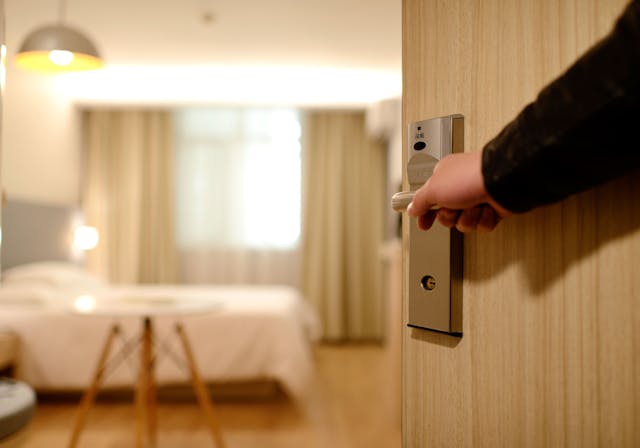Each year, bed bug populations reach new peaks, and California is no different. From hotels to hospitals, California residents have their hands full dodging these blood-sucking pests. Learning more about how these insects creep around can help you stop an infestation before it starts.
How do bed bugs spread? We have the answer for you!
In our blog, we’ll detail everything you need to know about bed bugs, from their development to how they end up in your home. With our in-depth knowledge and top-notch treatments, we can send these pests packing!
Bed Bug Behavior and Biology
Bed bugs are small, reddish-brown insects that feed on human and animal blood. Despite their name, bed bugs aren’t confined to your comforters. They can pop up in other furniture, clothing, baseboards, and electronics.
These nocturnal pests prefer to feed on their hosts while they sleep. During the day, bed bugs hide in cracks, crevices, and other sheltered locations near their host’s resting area. Common hiding spots include mattress seams, bed frames, baseboards, and electrical outlets.
Once you’re asleep, bed bugs will sneak over to exposed skin and feed, attracted by your body’s hearing and the carbon dioxide you exhale. The resulting bites often turn into itchy, red welts, but not everyone will have the same reaction.
Bed bugs require a blood meal to reproduce and thrive. With a suitable host, females can lay hundreds of eggs over their lifetime. These eggs are small, white, and approximately the size of a pinhead.
After hatching, bed bug nymphs go through five molting stages before reaching adulthood. Under optimal conditions, bed bugs can complete their life cycle in about a month!
Unfortunately, their quick reproduction isn’t the only thing that keeps infestations growing. Bed bugs are highly adaptable insects that survive for several months without feeding. They are resilient to many typical insecticides and can quickly develop resistance to chemical treatments.
How Do Bed Bugs Spread?
Ever wonder how bed bugs manage to sneak into new places? Let’s dive into the many ways bed bugs can spread so that you can stay one step ahead!

Travel
Bed bugs travel to new places by clinging to clothing, luggage, furniture, and other belongings. When people unknowingly transport infested items from one place to another, they can unintentionally spread bed bugs to new locations. This is particularly common in hotels, airports, and public transportation, where individuals come into contact with various surfaces.
Secondhand Furniture and Clothing
Purchasing secondhand furniture or clothing can introduce bed bugs into your home. These pests can hide in cracks and crevices of mattresses, sofas, and clothing, waiting for an opportunity to infest a new environment.
Social Gatherings
Bed bugs can also spread through social gatherings, where people come into close contact with one another. Parties, sleepovers, and other events allow bed bugs to transfer from one person to another, especially if infested clothing or belongings are shared.
Multi-Unit Dwellings
Apartment buildings, condominiums, and other multi-unit dwellings present ideal conditions for bed bugs to spread. Once inside a building, bed bugs can quickly infest multiple units, making control efforts more challenging. These pests can move between units through wall voids, electrical conduits, and shared plumbing systems.
Visitors and Guests
Visitors and guests can unknowingly introduce bed bugs into homes when they bring infested luggage or belongings in. Whether it’s a friend staying overnight or a family member visiting from out of town, anyone who brings infested items into your home can contribute to the spread of bed bugs.
Prevention Strategies
Keeping bed bugs at bay requires regular vigilance inside and outside your home. Here are several strategies you can use to prevent an infestation!

Routine Inspections
Frequently check your home for signs of bed bugs. Focus on common hiding spots like mattress seams, bed frames, headboards, and upholstered furniture. Look for live bugs, shed skins, and small rust-colored stains from their droppings.
Travel Precautions
Before settling in, inspect your hotel rooms for signs of bed bugs. Check the mattress, headboard, and surrounding areas. Keep your luggage elevated and away from beds or upholstered furniture. When you return home, inspect and clean your luggage; wash and dry all clothing in the hottest settings to kill any hitchhikers.
Secondhand Items
Be cautious when buying secondhand furniture, clothing, or other items. Inspect and clean these items before bringing them into your home. For furniture, consider using a steam cleaner since high temperatures can eliminate them with ease.
Declutter
Clutter provides ample hiding spaces for bed bugs. Keep your personal items off the floor and store belongings in sealed plastic containers.
Seal Entry Points
Seal cracks and crevices in walls, baseboards, and around pipes with caulk. This can prevent bed bugs from hiding in inaccessible areas and moving between rooms or units in multi-family dwellings.
Bed Bug-Proof Encasements
Use bed bug-proof mattress and box spring encasements, especially if you’re returning from a place known for bed bug infestations. These covers trap existing bed bugs and prevent new ones from infesting your bedding. Make sure to use high-quality encasements with zippers designed to keep bed bugs out.
Professional Inspections
If you suspect you have a bed bug infestation, contact a licensed pest control professional for an inspection and treatment. At Banner Pest Services, we have the expertise and tools to detect and address infestations early, preventing them from becoming more severe.
For trusted pest control solutions in the Bay Area, contact us today!


